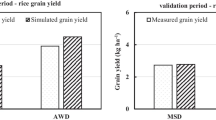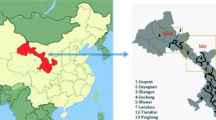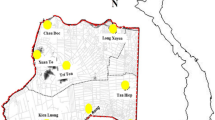Abstract
Sustainable utilization of blue water resources under climate change is of great significance especially for producing high water-consuming crops in water-scarce regions. Based on the virtual water concept, we carried out a comprehensive field-modeling research to find the optimal agricultural practices regarding rice blue water consumption under prospective climate change. The DSSAT-CERES-Rice model was used in combination with 20 GCMs under three Representative Concentration Pathways of low (RCP2.6), intermediate (RCP4.6), and very high (RCP8.5) greenhouse concentrations to predict rice yield and water requirement and related virtual water and economic return for the base and future periods. The crop model was calibrated and validated based on the 2-year field data obtained from consolidated paddy fields of the Sari Agricultural Sciences and Natural Resources University during 2011 and 2012 rice cropping cycles. Climate change imposes an increase of 0.02–0.04 °C in air temperature which consequently shifts rice growing seasons to winter season, and shorten the length of rice physiological maturity period by 2–15 days. While rice virtual water reduces by 0.1–20.6% during 2011–2070, reduced rice yield by 3.8–22.6% over the late twenty-first century results in a considerable increase in rice virtual water. By increasing the contribution of green water in supplying crop water requirement, earlier cropping could diminish blue water consumption for rice production in the region while cultivation postponement increases irrigation water requirement by 2–195 m3 ha−1. Forty days delay in rice cultivation in future will result in 29.9–40.6% yield reduction and 43.9–60% increase in rice virtual water under different scenarios. Earlier cropping during the 2011–2040 and 2041–2070 periods would increase water productivity, unit value of water, and economic value of blue water compared to the base period. Based on the results, management of rice cultivation calendar is a suitable strategy for sustainable blue water consumption for producing rice under future climate.


Similar content being viewed by others
References
Adams RM, Hurd BH, Lenhart S, Leary N (1998) Effects of global climate change on agriculture: an interpretative review. Clim Res 11:19–30. https://doi.org/10.3354/cr011019
Ainsworth EA, Long SP (2005) What have we learned from 15 years of Free-air CO2 enrichment (FACE)? A meta-analytic review of the responses of photosynthesis, canopy properties and plant production to rising CO2. New Phytol 165:351–372
Ali MH, Talukder MSU (2008) Increasing water productivity in crop production—a synthesis. Agric Water Manag 95(11):1201–1231. https://doi.org/10.1016/j.agwat.2008.06.008
Allen RG, Pereira LS, Raes D and Smith M 1998 Crop evapotranspiration: guidelines for computing crop water requirements. FAO Irrigation and Drainage Paper. 56. Rome, Italy. 300 pp
Chen J, Brissette FP, Leconte R (2011) Uncertainty of downscaling method in quantifying the impact of climate change on hydrology. J Hydrol 401 (3–4:190–202
Chen ZM, Chen GQ (2013) Virtual water accounting for the globalized world economy: national water footprint and international virtual water trade. Ecol Indic 28:142–149. https://doi.org/10.1016/j.ecolind.2012.07.024
Chen H, Guo J, Zhang Z, Xu C (2013) Prediction of temperature and precipitation in Sudan and South Suda by using LARS-WG in future. Theor Appl Climatol 113(3-4):363–375. https://doi.org/10.1007/s00704-012-0793-9
Chen H, Wu W, Liu HB (2016) Assessing the relative importance of climate variables to rice yield variation using support vector machines. Theor Appl Climatoal 126(1–2):105–111. https://doi.org/10.1007/s00704-015-1559-y
Croitoru AE, Piticar A, Dragota CS, Burada DC (2013) Recent changes in reference evapotranspiration in Romania. Glob Planet Chang 111:127–132. https://doi.org/10.1016/j.gloplacha.2013.09.004
Darzi-Naftchali A, Shahnazari A (2014) Influence of subsurface drainage on the productivity of poorly drained paddy fields. Eur J Agron 56:1–8. https://doi.org/10.1016/j.eja.2014.02.003
de- Silva CS, Weatherhead EK, Knox JW, Rodriguez-Diaz JA (2007) Predicting the impacts of climate change: a case study on paddy irrigation water requirements in Sri Lanka. Agric Water Manag 93(1–2):19–29
Deb P, Tran DA, Udmale PD (2015) Assessment of the impacts of climate change and brackish irrigation water on rice productivity and evaluation of adaptation measures in Ca Mau Province, Vietnam. Theor Appl Climatoal 125(3–4):641–656
Dharmarathna WRSS, Herath S, Weerakoon SB (2014) Changing the planting date as a climate change adaptation strategy for rice production in Kurunegala District, Sri Lanka. Sustain Sci 9(1):103–111. https://doi.org/10.1007/s11625-012-0192-2
Elgaali E, Garcia LA, Ojima DS (2007) High resolution modeling of the regional impacts of climate change on irrigation water demand. Clim Chang 84(3-4):441–461. https://doi.org/10.1007/s10584-007-9278-8
Fader M, Rost S, Müller C, Bondeau A, Gerten D (2010) Virtual water content of temperate cereals and maize: present and future patterns. J Hydrol 384(3-4):218–231. https://doi.org/10.1016/j.jhydrol.2009.12.011
FAO (2013) CROPWAT Model. [Online]. Food and Agriculture Organization, Rome. Available: www.fao.org/nr/water/inforesdatabasescropwat.html
Gerten D, Heinke J, Hoff H, Biemans H, Fader M, Waha K (2011) Global water availability and requirements for future food production. J Hydrometeorol 12(5):885–899. https://doi.org/10.1175/2011JHM1328.1
Haris AVA, Biswas S, Chhabra V, Elanchezhian R, Bhatt BP (2013) Impact of climate change on wheat and winter maize over a sub-humid climatic environment. Current Science(Bangalore) 104(2):206–214
He, L., Cleverly, J., Wang, B., Jin, N., Mi, C., Liu, D.L., Yu, Q. 2017. Multi-model ensemble projections of future extreme heat stress on rice across southern China. Theor Appl Climatoal, doi.org/10.1007/s00704-017-2240-4
Hoekstra AY, Mekonnen MM, Chapagain AK, Mathews RE, Richter BD (2012) Global monthly water scarcity: blue water footprints versus blue water availability. PLoS One 7(2):e32688. https://doi.org/10.1371/journal.pone.0032688
Hoogenboom G, Jones JW, Wilkens PW, Porter CH, Boote KH, Hunt LA, Singh U et al (2010) Decision support system for agrotechnology transfer, version 4.5. [CD-ROM]. University of Hawaii, Honolulu, HI
Hund A, Fracheboud Y, Soldati A, Stamp P (2008) Cold tolerance of maize seedlings as determined by root morphology and photosynthetic traits. Eur J Agron 28(3):178–185. https://doi.org/10.1016/j.eja.2007.07.003
IPCC. Climate Change (2014) Mitigation of climate change. Contribution of Working Group III to the Fifth Assessment Report of the Intergovernmental Panel on Climate Change Edenhofer, O., R. Pichs-Madruga, Y. Sokona, E. Farahani, S. Kadner, K. Seyboth, A. Adler, I. Baum, S. Brunner, P. Eickemeier, B. Kriemann, J. Savolainen, S. Schlomer, C. von Stechow, T. Zwickel and J.C. Minx (eds.). Cambridge University Press, Cambridge, United Kingdom and New York, NY, USA
Jones PD, Hulme M (1996) Calculating regional climatic times series for temperature and precipitation: methods and illustrations. Int J Climatol 16(4):361–377. https://doi.org/10.1002/(SICI)1097-0088(199604)16:4<361::AID-JOC53>3.0.CO;2-F
Jones JW, Hoogenboom G, Porter CH, Boote KJ, Batchelor WD, Hunt LA, Wilkens PW, Singh U, Gijsman AJ, Ritchie JT (2003) The DSSAT cropping system model. Eur J Agron 18(3-4):235–265. https://doi.org/10.1016/S1161-0301(02)00107-7
Kadiyala MDM, Jones JW, Mylavarapu RS, Li YC, Reddy MD (2015) Identifying irrigation and nitrogen best management practices foraerobic rice–maize cropping system for semi-arid tropics using CERES-rice and maize models. Agric Water Manag 149:23–32. https://doi.org/10.1016/j.agwat.2014.10.019
Karandish F (2016) Improved soil–plant water dynamics and economic water use efficiency in a maize field under locally water stress. Arch Agron Soil Sci 62(9):1311–1323. https://doi.org/10.1080/03650340.2015.1135326
Karandish F, Salari S, Darzi-Naftchali A (2015) Application of virtual water trade to evaluate cropping pattern in arid regions. Water Resour Manag 29(11):4061–4074. https://doi.org/10.1007/s11269-015-1045-4
Karandish F, Mousavi SS (2016) Climate change uncertainty and risk assessment in Iran during twenty-first century: evapotranspiration and green water deficit analysis. Theor Appl Climatol:1–15
Karandish F, Mousavi SS, Tabari H (2017) Climate change impact on precipitation and cardinal temperatures in different climatic zones in Iran: analysing the probable effects on cereal water-use efficiency. Stoch Environ Res Risk Assess 31(8):2121–2146. https://doi.org/10.1007/s00477-016-1355-y
Keeney DR, Nelson DW (1982) Nitrogen-inorganic forms. In: Methods of soil analysis, agronomy monograph 9, Part 2 (2nd ed.; pp. 643–698), Am. Soc. Agron., Madison
Kelkar U, Bhadwal S (2007) South Asian regional study on climate change impacts and adaptation: implications for human development [Report]. Human Development Report Office, Sri Lanka
Kimbal BA, Kobayashi K, Bindi M (2002) Responses of agricultural crops to free air CO2 enrichment. Adv Agron 77:293–368. https://doi.org/10.1016/S0065-2113(02)77017-X
Knutti R, Stocker TF, Joos F, Plattner GK (2003) Probabilistic climate change projections using neural networks. Clim Dyn 21(3):257–272. https://doi.org/10.1007/s00382-003-0345-1
Krishnan P, Swain DK, Chandra Bhaskar B, Nayak SK, Dash RN (2007) Impact of elevated CO2 and temperature on rice yield and methods of adaptation as evaluated by crop simulation studies. Agric Ecosyst Environ 122(2):233–242. https://doi.org/10.1016/j.agee.2007.01.019
Konar M, Hussein Z, Hanasaki N, Mauzerall DL, Rodriguez-Iturbe I (2013) Virtual water trade flows and savings under climate change. Hyrol Earth Syst Sci 17(8):3219–3234. https://doi.org/10.5194/hess-17-3219-2013
Ma C, Pan S, Wang G, Liao Y, Xu YP (2015) Changes in precipitation and temperature in Xiangjiang River basin. China Theor Appl Climatoal 123(3-4):859–871. https://doi.org/10.1007/s00704-015-1386-1
Marin FR, Jones JW, Singels A, Royce F, Assad ED, Pellegrino GQ, Justino F (2013) Climate change impacts on sugarcane attainable yield in southern Brazil. Clim Chang 117(1):227–239. https://doi.org/10.1007/s10584-012-0561-y
Mainuddin M (2011) Agricultural productivity and food security in the lower Mekong Basin: impacts of climate change and options for adaptation. CSIRO Land and Water, Canberra
Minville M, Brissette F, Leconte R (2008) Uncertainty of the impact of climate change on the hydrology of a Nordic watershed. J Hydrol 358(1–2):70–83. https://doi.org/10.1016/j.jhydrol.2008.05.033
Moratiel R, Snyder RL, Durn JM, Tarquis AM (2011) Trends in climatic variables and future reference evapotranspiration in Duero Valley (Spain). Nat Hazards Earth Syst Sci 11(6):1795–1805. https://doi.org/10.5194/nhess-11-1795-2011
Nash JE, Sutcliffe JV (1970) River flow forecasting through conceptual models. A discussion of principles. J Hydrol 10(3):282–290. https://doi.org/10.1016/0022-1694(70)90255-6
Nkomozepi T, Chung SO (2014) The effect of climate change on the water resources of the Geumho River basin, Republic of Korea, J. Hydro-environment Research xx:1–9
Orlowsky B, Hoekstra AY, Gudmundsoon L, Senevirante SL (2014) Today’s virtual water consumption and trade under future water scarcity. Environ Res Lett 9(7):074007 (10 pp). https://doi.org/10.1088/1748-9326/9/7/074007
Page AL, Miller RH and Keeney DR 1982 Methods of soil analysis, part 2. Chemical and microbiological properties. American Society of Agronomy, Inc. Soil Science of American, Inc, Madison, Wisconsin, USA
Pearson CJ, Bucknell D, Laughlin GP (2008) Modelling crop productivity and variability for policy and impacts of climate change in eastern Canada. Environ Model Softw 23(12):1345–1355. https://doi.org/10.1016/j.envsoft.2008.02.008
Peng SB, Huang JL, Sheehy JE, Laza RC, Visperas RM, Zhong XH, Centeno GS, Khush GS, Cassman KG (2004) Rice yields decline with higher night temperature from global warming. Proceedings of the National Academy of Sciences, U.S.A 101:9971–9975
Peterson TC, Golubev VS, Groisman PY (2002) Evaporation losing its strength. Nature 377:687–688
Prasad PVV, Boote KJ, Allen LH Jr, Sheehy JE, Thomas JMG (2006) Species, ecotype and cultivar differences in spikelet fertility and harvest index of rice in response to high temperature stress. Field Crops Res 95:398–411
Rao BB, Santhibhushan Chowdary P, Sandeep VM, Rao VUM, Venkateswarlu B (2014) Rising minimum temperature trends over India in recent decades: implications for agricultural production. Glob Planet Chang 117:1–8
Ritzema, H., 1994. Drainage principles and applications, chapter 8, subsurface flow to drains. IILRI, Wageningen, the Netherlands 1124 pp.
Rodriguez Diaz JA, Weatherhead EK, Knox JW, Camacho E (2007) Climate change impacts on irrigation water requirements in the Guadalquivir river basin in Spain. Reg Environ Chang 7(3):149–159. https://doi.org/10.1007/s10113-007-0035-3
Sandhu SS, Prabhjyot-Kaur, Gill KK (2013) Weather based agro indices and grain yield of rice cultivars transplanted on different dates in Punjab. Int J Agric Food Sci Technol 4(10):1019–1026
Serur AB, Sarma AK (2017) Current and projected water demand and water availability estimates under climate change scenarios in the Weyib River basin in Bale mountainous area of southeastern Ethiopia. Theor Appl Climatoal. https://doi.org/10.1007/s00704-017-2219-1
Shrestha, S., 2014. Climate change impacts and adaptation in water resources and water use sectors, Springer Water, Springer International Publishing Switzerland, https://doi.org/10.1007/978-3-319-09746-6_5
Soler CMT, Sentelhas PC, Hoogenboom G (2007) Application of the CSM-CERES-Maize model for planting date evaluation and yield forecasting for maize grown off-season in a subtropical environment. Eur J Agron 27(2):165–177. https://doi.org/10.1016/j.eja.2007.03.002
Terink W, Immerzeel WW, Droogers P (2013) Climate change projections of precipitation and reference evapotranspiration for the Middle East and Northern Africa until 2050. Int J Climatol 33(14):3055–3072. https://doi.org/10.1002/joc.3650
Trzaska, S., Schnarr, E. 2014. A review of downscaling methods for climate change projections. USAID, 56p
Valero RMM, Avalos JMM, Vazquez EV (2012) Estimation of the daily water consumption by maize under Atlantic climatic conditions (A Coru˜ na, NW Spain) using frequency domain reflectometry—a case study. Nat Hazards Earth Syst Sci 12(3):709–714. https://doi.org/10.5194/nhess-12-709-2012
Vilayvong S, Banterng P, Patanothai A, Pannangpetch K (2012) Evaluation of CSM-CERES-Rice in simulating the response of lowland rice cultivars to nitrogen application. Aust J Crop Sci 6:1534–1541
Yoshida S (1981) Fundamentals of rice crop science. IRRI, Los Banos, p 269
Zhang HL, Zhao X, Yin XG, Liu SL, Xue JF, Wang M, Pu C, Chen F (2015) Challenges and adaptations of farming to climate change in the North China Plain. Clim Chang 129(1):213–224. https://doi.org/10.1007/s10584-015-1337-y
Zhao Q, Liu J, Khabarov N, Obersteiner M, Westphal M (2014) Impacts of climate change on virtual water content of crops in China. Ecological Informatics 19:26–34
Author information
Authors and Affiliations
Corresponding author
Rights and permissions
About this article
Cite this article
Darzi-Naftchali, A., Karandish, F. Adapting rice production to climate change for sustainable blue water consumption: an economic and virtual water analysis. Theor Appl Climatol 135, 1–12 (2019). https://doi.org/10.1007/s00704-017-2355-7
Received:
Accepted:
Published:
Issue Date:
DOI: https://doi.org/10.1007/s00704-017-2355-7




